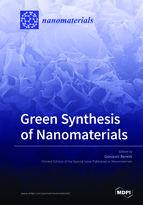Green Synthesis of Nanomaterials
A special issue of Nanomaterials (ISSN 2079-4991).
Deadline for manuscript submissions: closed (15 April 2019) | Viewed by 69538
Special Issue Editor
Interests: arthropod vectors; entomology; insect control; mosquitoes; nano-synthesis; nanoparticles; nano-pesticides; nanotechnology; non-target effects; ticks
Special Issues, Collections and Topics in MDPI journals
Special Issue Information
Dear Colleagues,
Nanomaterials possess astonishing physical and chemical properties. They have a key role in the development of novel and effective drugs, catalysts, sensors, and pesticides, to cite just a few examples. Notably, the synthesis of nanomaterials is usually achieved with chemical and physical methods needing the use of extremely toxic chemicals or high-energy inputs. To move towards more eco-friendly processes, researchers have recently focused on so-called “green synthesis”, where microbial, animal-, and plant-borne compounds can be used as cheap reducing and stabilizing agents to fabricate nanomaterials. Green synthesis routes are cheap, environmentally sustainable, and can lead to the fabrication of nano-objects with controlled size and shape—two key features determining their bioactivity.
However, real-world applications of green-fabricated nanomaterials are largely unexplored. Besides, what do we really know about their non-target toxicity? Which are their main modes of action? What is their possible fate in the environment? In this framework, the present Special Issue will include articles by expert authorities on nanomaterials synthesis and applications. Special emphasis will be devoted to their impact on the environment and long-term toxicity.
Prof. Dr. Giovanni Benelli
Guest Editor
Manuscript Submission Information
Manuscripts should be submitted online at www.mdpi.com by registering and logging in to this website. Once you are registered, click here to go to the submission form. Manuscripts can be submitted until the deadline. All submissions that pass pre-check are peer-reviewed. Accepted papers will be published continuously in the journal (as soon as accepted) and will be listed together on the special issue website. Research articles, review articles as well as short communications are invited. For planned papers, a title and short abstract (about 100 words) can be sent to the Editorial Office for announcement on this website.
Submitted manuscripts should not have been published previously, nor be under consideration for publication elsewhere (except conference proceedings papers). All manuscripts are thoroughly refereed through a single-blind peer-review process. A guide for authors and other relevant information for submission of manuscripts is available on the Instructions for Authors page. Nanomaterials is an international peer-reviewed open access semimonthly journal published by MDPI.
Please visit the Instructions for Authors page before submitting a manuscript. The Article Processing Charge (APC) for publication in this open access journal is 2900 CHF (Swiss Francs). Submitted papers should be well formatted and use good English. Authors may use MDPI's English editing service prior to publication or during author revisions.
Keywords
- chronic toxicity
- nanoparticles
- nanopesticides
- environmental applications
- environmental fate
- genotoxicity
- insecticides
- nanotoxicity
- non-target effects
- sub-lethal effects
- antimicrobials
- drug development
- nanocarriers
- catalysts
- sensors







